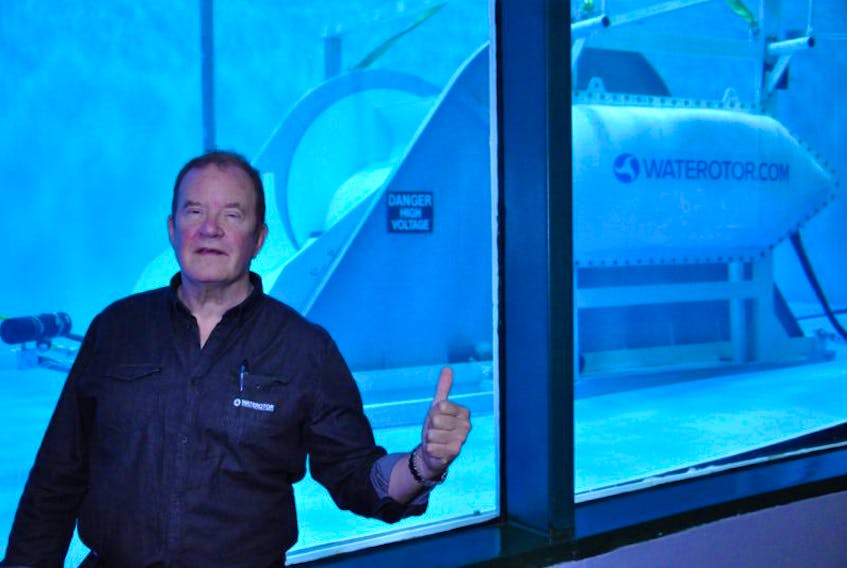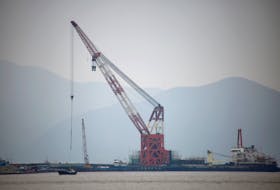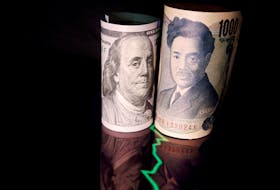Waterotor Energy Technologies have been conducting tests in the Flume Tank at the Marine Institute as they prepare to enter the licensing phase and the first level of production.
“These are tests here in the world’s biggest flow tank to verify last adjustments as we basically sign off on the production drawings for our manufacturers,” explains CEO and founder Fred Ferguson.
The push of water against the Waterotor’s blades rotates a drum that converts the mechanical energy to electrical energy by way of generators.
Unlike traditional hydroelectric methods that rely on tidal power or propeller devices in higher water-flow speeds, the device can operate in flows as slow as two miles per hour, extracting more than half the theoretical energy.
The company says more than 71 per cent of the planet has slow moving water in rivers, canals and ocean currents.
The power it generates is also incredibly cost-effective.
“You take the capital costs, meaning the purchase price of one of our 20 kilowatt units and if you put it in water it'll run 24 hours a day, seven days a week, 360 days a year — we allow five days of downtime — if you project that out over 10 years you get to less than five cents per kilowatt hour,” explains Ferguson.
The Waterotor is non-invasive and green technology. Fish approaching the rotor meet a pressure bubble and pass over the top of it and it doesn’t create the same environment concerns of a hydroelectric project dam.
“This device does not dam the river, so you can have a bunch of these in an array, in a line and you're not actually changing the level of the water, so the nearby villages and whatnot are not going to be flooded,” says retired Canadian Forces Brig.-Gen. Gregory Matte, a company investor and strategic advisor.
It’s also predictable power in so much as individual units can be turned on and off to reflect the power needs at certain times of the day.
“At nightfall, if the demand goes up, you can unlock two or three or four and be producing more energy during that period of time when you know the demand will be higher and shut them off when you don't need them,” says Matte.
In addition to the industrial size unit, which Ferguson says can power up to nine North American homes, the company has designed a medium sized unit that has already garnered the attention of some oil industry players who operate unmanned rigs, and a consumer unit that can produce enough power to a cabin.
“We can build these all the way up to one megawatt in size, we're just not doing it right away,” says Ferguson.
“We're at an infancy that in maybe 10 years you'd see very large versions of this so, just like the Wright Brothers today has become jumbo jets, we're going to compress that time frame and you'll see the jumbo jet of this in 10 or 12 years from now.”
The primary market for the technology is in the Philippines, Malaysia, Indonesia and Micronesia, much of which is without power.
“It's the third-world countries that are all jammed up with population, in many cases there's no electricity at all and this is a good solution for that at a relatively cheap price,” says Ferguson.
But he underscores the importance of this technology in remote Canadian communities where they currently depend on burning expensive fossil fuels to meet their energy demands.
“We see big markets like Indonesia and Malaysia because they're paying 45 to 66 cents per kilowatt hour, but in Canada's north it's like $1.50,” says Ferguson.
“The coke machines up there have expensive cokes in them, but they're unplugged because a coke machine takes $870 worth of power a month to run.
Matte, who has the licensing rights in Canada, says the technology should be of interest to the federal and provincial governments for a number of reasons. As a renewable energy it meets the Paris Accord responsibilities; it reduces pollution from fossil fuels; there’s no noise like that created from generators; it’s an innovative Canadian technology; and it’s an exportable product that can create jobs.
It also has the potential to provide energy independence to 292 remote locations in the Canadian North.
“This would provide them a micro-grid scaled to the needs of their village, however big it may be, but they don't rely on the logistics of bringing in fossil fuels,” Matte says.
Ferguson says the company won’t be entering the manufacturing game, choosing to design, test and license the technology for production.
“The reason we're doing that is if we don't allow this to be licensed or broadly put out into various territories and manufacturers it's such a good breakthrough that we'll be fight copycats,” he says.
“That's not to say we're going to own 100 per cent of the market, we just want to be a mature part of it.”
The company will conclude its tests over the coming days, but will return to Marine Institute in a couple of months time, this time with representatives from high profile client Lockheed Martin in tow.
Twitter: kennoliver79









